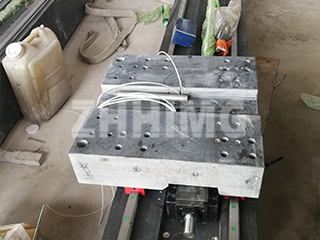Granite components are essential precision tools widely used in mechanical measurement and inspection. Their production and maintenance require meticulous attention to detail to ensure long-lasting performance and accuracy. One critical aspect of granite component manufacturing is splicing, which involves assembling multiple granite pieces while maintaining precision and structural integrity.
During splicing, threaded connections must incorporate anti-loosening devices to maintain stability. Common solutions include double nuts, spring washers, cotter pins, retaining washers, round nuts, and flower washers. Bolts should be tightened in symmetrical sequences, and threaded ends must extend beyond the nuts to ensure secure fastening. Proper gap treatment between spliced components not only enhances the product’s appearance but also has no adverse effect on measurement precision.
Granite’s chemical composition further supports its durability and performance. Comprising primarily silicon dioxide (SiO₂ > 65%) with minor amounts of iron oxides, magnesium oxide, and calcium oxide, granite exhibits exceptional hardness, wear resistance, and dimensional stability. These properties make it ideal for long-term use in precision measurement applications.
The service life of granite components largely depends on proper care and quality. After each use, the working surface should be cleaned with a neutral solution, ensuring it is free from dust and particles. Regular maintenance prevents scratches and preserves the component’s flatness and precision. While cost considerations are common, it is important to prioritize quality over price; high-quality granite components deliver long-term reliability and accuracy that cheaper alternatives cannot match.
Inspecting granite components can be done through two primary methods: platform inspection and instrument measurement. By using a granite flat plate as a reference plane, precise measurements can be taken with auxiliary tools such as cylinders, steel balls, small squares, and cylindrical squares. The consistent radius of cylinders or steel balls ensures accurate height and flatness measurements at multiple points across the component’s surface, enabling high-precision inspection in mechanical and industrial applications.
Careful handling during production is crucial. Granite is naturally durable, but its components are fragile and must be protected from impact and abrasion. Proper packaging is therefore essential to ensure safe delivery to customers. Typically, a thick layer of foam is applied to the granite surface, with additional padding around the wooden box. The wooden packaging may then be reinforced with a cardboard outer layer, and all shipments should carry clear “Fragile, Handle with Care” labels. Partnering with a reputable logistics company ensures that components arrive intact and ready for use.
In conclusion, granite components combine the inherent stability of natural stone with precise engineering and careful handling to deliver unmatched accuracy and durability. From splicing and installation to daily maintenance and proper packaging, every step is critical in maximizing their service life and ensuring reliable performance in precision measurement applications.
Post time: Sep-18-2025

